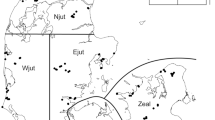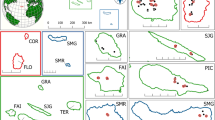Abstract
Quantifying survey completeness is a key step in designing and interpreting biodiversity assessments. To date this has only been examined either at a local scale through repetitive sampling, or across broader geographic areas through multiple survey sites. In this paper, we determine the completeness of sampling at both local and continental scales, of the phytophagous arthropod assemblage on the Neotropical shrub Parkinsonia aculeata (Leguminosae). We used survey gap analysis (SGA) to determine whether existing surveys adequately sampled the diversity of environments and geographic space covered by the plant. Within defined geographic regions, we determined survey completeness at a local scale with species accumulation curves. SGA identified the highest priority sites for future sampling in the Sonoran Desert and the Pacific Coast of South America. The arthropods sampled on P. aculeata differed significantly between seasons, highlighting the importance of including surveys throughout the year. At the local scale, surveys in most regions were estimated to have sampled <50 % of all species. Only the Mexican Gulf, following 84 samples including 902 individuals, had a reasonably complete sample of all species (more than 50 %). As in other studies, rare species will continue to be detected even after extensive surveying, and it is likely that close to 100 samples or 1,000 individuals will be needed to attain 50 % survey completeness in a region. However, if the objective is to document close “host-associations” then effort may be better directed at surveying ecologically distinct new areas rather than exhaustive sampling in existing ones. Methods such as SGA can direct such surveys, and in conjunction with species-richness estimates, can be used to assess the adequacy of existing surveys.





Similar content being viewed by others
References
Anderson MJ (2001) A new method for non-parametric multivariate analysis of variance. Austral Ecol 26:32–46
Antonelli A, Nylander JAA, Persson C, Sanmartin I (2009) Tracing the impact of the Andean uplift on Neotropical plant evolution. Proc Natl Acad Sci USA 106:9749–9754. doi:10.1073/pnas.0811421106
Aranda SC, Gabriel R, Borges PAV, Lobo JM (2010) Assessing the completeness of bryophytes inventories: an oceanic island as a case study (Terceira, Azorean archipelago). Biodivers Conserv 19:2469–2484
Aukema BH, Richards GR, Krauth SJ, Raffa KF (2004) Species assemblage arriving at and emerging from trees colonized by Ips pini in the Great Lakes region: partitioning by time since colonization, season and host species. Ann Entomol Soc Am 97:117–129
Baselga A (2008) Determinants of species richness, endemism and turnover in European longhorn beetles. Ecography 31:263–271
Basset Y (2001) Invertebrates in the canopy of tropical rain forests. How much do we really know? Plant Ecol 153:87–107
Basset Y et al (2012) Arthropod diversity in a tropical forest. Science 338:1481–1484. doi:10.1126/science.1226727
Bell KL, Heard TA, Manion G, Ferrier S, Van Klinken RD (2013) The role of geography and environment in species turnover: phytophagous arthropods on a Neotropical legume. J Biogeogr 40:1755–1766
Brito D (2010) Overcoming the Linnean shortfall: data deficiency and biological survey priorities. Basic Appl Ecol 11:709–713
Cardoso P et al (2009) Species richness and composition assessment of spiders in a Mediterranean scrubland. J Insect Conserv 13:45–55
Chao A (1987) Estimating the population size for capture-recapture data with unequal catchability. Biometrics 43:783–791
Chao A, Jost L (2012) Coverage-based rarefaction and extrapolation: standardizing samples by completeness rather than size. Ecology 93:2533–2547
Chao A, Chazdon RL, Colwell RK, Shen TJ (2005) A new statistical approach for assessing similarity of species composition with incidence and abundance data. Ecol Lett 8:148–159. doi:10.1111/j.1461-0248.2004.00707.x
Chao A, Colwell RK, Lin CW, Gotelli NJ (2009) Sufficient sampling for asymptotic minimum species richness estimators. Ecology 90:1125–1133
Coddington JA, Agnarsson I, Miller JA, Kuntner M, Hormiga G (2009) Undersampling bias: the null hypothesis for singleton species in tropical arthropod surveys. J Anim Ecol 78:573–584. doi:10.1111/j.1365-2656.2009.01525.x
Colwell RK (2013) EstimateS: Statistical estimation of species richness and shared species from samples, 9 edn. Department of Ecology & Evolutionary Biology, University of Connecticut, Storrs, CT, USA
Colwell RK, Chao A, Gotelli NJ, Lin S-Y, Mao CX, Chazdon RL, Longino JT (2012) Models and estimators linking individual-based and sample-based rarefaction, extrapolation and comparison of assemblages. J Plant Ecol 5:3–21
Costello MJ, Wilson S, Houlding B (2012) Predicting total global species richness using rates of species description and estimates of taxonomic effort. Syst Biol 61:871–883
de Souza JLP, de Moura CAR, Franklin E (2009) Efficiency in inventories of ants in a forest reserve in Central Amazonia. Pesqui Agropecu Bras 44:940–948. doi:10.1590/s0100-204x2009000800021
de Thoisy B, Brosse S, Dubois MA (2008) Assessment of large-vertebrate species richness and relative abundance in neotropical forest using line-transect censuses: what is the minimal effort required? Biodivers Conserv 17:2627–2644
Ding J, Fu W, Reardon R, Wu Y, Zhang G (2004) Exploratory survey in China for potential insect biocontrol agents of mile-a-minute weed, Polygonum perfoliatum L., in Eastern USA. Biol Control 30:487–495
Elias M et al (2009) Out of the Andes: patterns of diversification in clearwing butterflies. Mol Ecol 18:1716–1729. doi:10.1111/j.1365-294X.2009.04149.x
Erwin TL (1982) Tropical forests: their richness in Coleoptera and other arthropod species. Coleopt Bull 36:74–75
Erwin TL (1991) How many species are there?—revisited. Conserv Biol 5:330–333
Espírito-Santo HMV, Magnusson WE, Zuanon J, Mendonça FP, Landeiro VL (2009) Seasonal variation in the composition of fish assemblages in small Amazonia forest streams: evidence for predictable changes. Freshw Biol 54:536–548
Faith DP, Walker PA (1996) Environmental diversity: on the best-possible use of surrogate data for assessing the relative biodiversity of sets of areas. Biodivers Conserv 5:399–415
Ferrier S (2002) Mapping spatial pattern in biodiversity for regional conservation planning: where to from here? Syst Biol 51:331–363
Ferrier S, Drielsma M, Manion G, Watson G (2002) Extended statistical approaches to modelling spatial pattern in biodiversity in northeast New South Wales. II. Community-level modelling. Biodivers Conserv 11:2309–2338
Ferrier S, Manion G, Elith J, Richardson K (2007) Using generalized dissimilarity modelling to analyse and predict patterns of beta diversity in regional biodiversity assessment. Divers Distrib 13:252–264
Funk VA, Richardson KS, Ferrier S (2005) Survey-gap analysis in expeditionary research: where do we go from here? Biol J Linn Soc 85:549–567
García-Roger EM et al (2011) Do seasonal changes in habitat features influence aquatic macroinvertebrate assemblages in perennial versus temporary Mediterranean streams? Aquat Sci 73:567–579
Gotelli NJ, Colwell RK (2001) Quantifying biodiversity: procedures and pitfalls in the measurement and comparison of species richness. Ecol Lett 4:379–391
Grimbacher PS, Stork NE (2009) Seasonality of a diverse beetle assemblage inhabiting lowland tropical rain forest in Australia. Biotropica 41:328–337
Hawkins JA, Boutaoui N, Cheung KY, van Klinken RD, Hughes CE (2007) Intercontinental dispersal prior to human translocation revealed in a cryptogenic invasive tree. New Phytol 175:575–587. doi:10.1111/j.1469-8137.2007.02125.x
Heard TA, Pettit W (2005) Review and analysis of the surveys for natural enemies of Mimosa pigra: what does it tell us about surveys for broadly distributed hosts? Biol Control 34:247–254. doi:10.1016/j.biocontrol.2005.05.017
Heard TA Parkinsonia aculeata: surveys for natural enemies, native range ecological studies, and prospects for biological control. In: Preston C, Watts JH, Crossman ND (eds) Fifteenth Australian Weeds Conference proceedings: managing weeds in a changing climate, 2006. Weed Management Society of South Australia, Adelaide, Adelaide, pp 581–584
Hortal J, Lobo JM (2005) An ED-based protocol for optimal sampling of biodiversity. Biodivers Conserv 14:2913–2947. doi:10.1007/s10531-004-0224-z
Lafferty KD, Shaw JC, Kuris AM (2008) Reef fishes have higher parasite richness at un fished Palmyra Atoll compared to fished Kiritimati Island. EcoHealth 5:338–345
Lobo JM (2008) Database records as a surrogate for sampling effort provide higher species richness estimations. Biodivers Conserv 17:873–881. doi:10.1007/s10531-008-9333-4
Lovell SJ, Hamer ML, Slotow RH, Herbert D (2010) Assessment of sampling approaches for a multi-taxa invertebrate survey in a South African savanna-mosaic ecosystem. Austral Ecol 35:357–370
McArdle BH, Anderson MJ (2001) Fitting multivariate models to community data: a comment on distance-based redundancy analysis. Ecology 82:290–297
McKay F, Oleiro M, Walsh GC, Gandolfo D, Cuda JP, Wheeler GS (2009) Natural enemies of Brazilian peppertree (Sapindales: Anacardiaceae) from Argentina: their possible use for biological control in the USA. Fla Entomol 92:292–303
Melo AS, Froehlich CG (2001) Evaluation of methods for estimating macroinvertebrate species richness using individual stones in tropical streams. Freshw Biol 46:711–721
Merlo MJ, Parietti M, Etchegoin JA (2010) Evaluation of species richness estimators in studies of diversity involving two larval digenean communities parasitizing snail hosts. Parasitol Res 107:1093–1102
Moir ML, Brennan KEC, Fletcher MJ, Majer JD, Koch JM (2011) Multi-scale patterns in the host specificity of plant-dwelling arthropods: the influence of host plant and temporal variation on species richness and assemblage composition of true bugs (Hemiptera). J Nat Hist 45:41–42
Morrone JJ (2006) Biogeographic areas and transition zones of Latin America and the Caribbean Islands based on panbiogeographic and cladistic analyses of the entomofauna. Annu Rev Entomol 51:467–494
Morse GE, Farrell BD (2005) Interspecific phylogeography of the Stator limbatus species complex: the geographic context of speciation and specialization. Mol Phylogenet Evol 36:201–213
Muelelwa MI, Foord SH, Dippenaar-Schoeman AS, Stam EM (2010) Towards a standardized and optimized protocol for rapid biodiversity assessments: spider species richness and assemblage composition in two savanna vegetation types. Afr Zool 45:273–290
Müller-Schärer H, Lewinsohn TM, Lawton JH (1991) Searching for weed biocontrol agents—when to move on? Biocontrol Sci Technol 1:271–280
Ndiritu GG, Spiegel FW, Stephenson SL (2009) Distribution and ecology of the assemblages of myxomycetes associated with major vegetation types in Big Bend National Park. USA Fungal Ecol 2:168–183
Novotny V, Basset Y (2000) Rare species in communities of tropical insect herbivores: pondering the mystery of singletons. Oikos 89:564–572
Novotny V et al (2003) Colonising aliens: caterpillars (Lepidoptera) feeding on Piper aduncum and P. umbellatum in rainforests of Papua New Guinea. Ecol Entomol 28:704–716
Ødegaard F (2004) Species richness of phytophagous beetles in the tropical tree Brosimum utile (Moraceae): the effects of sampling strategy and the problem of tourists. Ecol Entomol 29:76–88
Ødegaard F (2006) Host specificity, alpha- and beta-diversity of phytophagous beetles in two tropical forests in Panama. Biodivers Conserv 15:83–105
Oksanen J, Kindt R, Legendre P, O’Hara B (2009) Vegan: community ecology package
Pennington RT, Lavin M, Oliveira A (2009) Woody plant diversity, evolution, and ecology in the tropics: perspectives from seasonally dry tropical forests. Annu Rev Ecol Evol Syst 40:437–457. doi:10.1146/annurev.ecolsys.110308.120327
Poulin R (2004) Parasite species richness in New Zealand fishes: a grossly underestimated component of biodiversity? Divers Distrib 10:31–37
Prado DE (1993) What is the Gran Chaco vegetation in South America? II. A redefinition. Contribution to the study of flora and vegetation of the Chaco. VII. Candollea 48:615–629
Reddy CS (2010) Survey-gap analysis for botanical research using integrated approach through taxonomical data and geoinformatics. J Ind Soc Remote Sens 38:577–584
Santos EMR, Franklin E, Magnusson WE (2008) Cost-efficiency of subsampling protocols to evaluate oribatid-mite communities in an Amazonian Savanna. Biotropica 40:728–735. doi:10.1111/j.1744-7429.2008.00425.x
Scharff N, Coddington JA, Griswold CE, Hormiga G, Bjorn PD (2003) When to quit? Estimating spider species richness in a northern European deciduous forest. J Arachnol 31:246–273
Selmi S, Boulinier T (2003) Does time of season influence bird species number determined from point-count data? A capture-recapture approach. J Field Ornithol 74:349–356
Shmida A, Wilson MV (1985) Biological determinants of species diversity. J Biogeogr 12:1–20
Soberón J, Llorente J (1993) The use of species accumulation functions for the prediction of species richness. Conserv Biol 7:480–488
Strong DR, Lawton JH, Southwood R (1984) Insects on plants: community patterns and mechanisms. Blackwell Scientific Publications, Oxford
Sujii ER, Fontes EG, Pires CSS, Teixeira CAD (1996) Application of multivariate analysis for the selection of candidates for biological control agents. Biol Control 7:288–292
Summerville KS, Crist TO (2005) Temporal patterns of species accumulation in a survey of Lepidoptera in a beech-maple forest. Biodivers Conserv 14:3393–3406. doi:10.1007/s10531-004-0546-x
Thompson GG, Thompson SA, Withers PC, Fraser J (2007) Determining adequate trapping effort and species richness using species accumulation curves for environmental impact assessments. Austral Ecol 32:570–580. doi:10.1111/j.1442-9993.2007.01729.x
Tulloch AIT, Mustin K, Possingham HP, Szabo JK, Wilson KA (2013) To boldly go where no volunteer has gone before: predicting volunteer activity to prioritize surveys at the landscape scale. Divers Distrib 19:465–480
van Klinken RD, Campbell SD, Heard TA, McKenzie J, March N (2009a) The biology of Australian weeds. 54. Parkinsonia aculeata L. Plant Prot Q 24:100–117
van Klinken RD, Lawson BE, Zalucki MP (2009b) Predicting invasions in Australia by a neotropical shrub under climate change: the challenge of novel climates and parameter estimation. Glob Ecol Biogeogr 18:688–700. doi:10.1111/j.1466-8238.2009.00483.x
Williams VL, Witkowski ETF, Balkwill K (2007) The use of incidence-based species richness estimators, species accumulation curves and similarity measures to appraise ethnobotanical inventories from South Africa. Biodivers Conserv 16:2495–2513. doi:10.1007/s10531-006-9026-9
Woods W (1992) Phytophagous insects collected from Parkinsonia aculeata [Leguminosae: Caesalpiniaceae] in the Sonoran Desert region of southwestern United States and Mexico. Entomophaga 37:465–474
Zotz G, Bermejo P, Dietz H (1999) The epiphyte vegetation of Annona glabra on barro colorado Island. Panama J Biogeogr 26:761–776
Acknowledgments
The authors thank Ricardo Segura, Quiyari Santiago, Carlos Pascacio and Moises Martinez (CSIRO Mexican Field Station), and Hugo Cordo and Fernando Mackay (USDA Argentina) for assistance with field work. We also thank W. Woods for providing unpublished data on the arthropod fauna of P. aculeata in Texas, USA, north-eastern Mexico, and Costa Rica. M. Morrone kindly provided GIS shapefiles, created by P. Löwenberg Neto, of the biogeographic provinces outlined in his 2006 paper. J. Murray assisted with GIS methods. The manuscript was improved with comments from R. Didham. This project was funded by Meat and Livestock Australia and Land and Water Australia.
Author information
Authors and Affiliations
Corresponding author
Additional information
Communicated by Anurag chaurasia.
Electronic supplementary material
Below is the link to the electronic supplementary material.
Rights and permissions
About this article
Cite this article
Bell, K.L., Heard, T.A., Manion, G. et al. Characterising the phytophagous arthropod fauna of a single host plant species: assessing survey completeness at continental and local scales. Biodivers Conserv 23, 2985–3003 (2014). https://doi.org/10.1007/s10531-014-0758-7
Received:
Revised:
Accepted:
Published:
Issue Date:
DOI: https://doi.org/10.1007/s10531-014-0758-7




